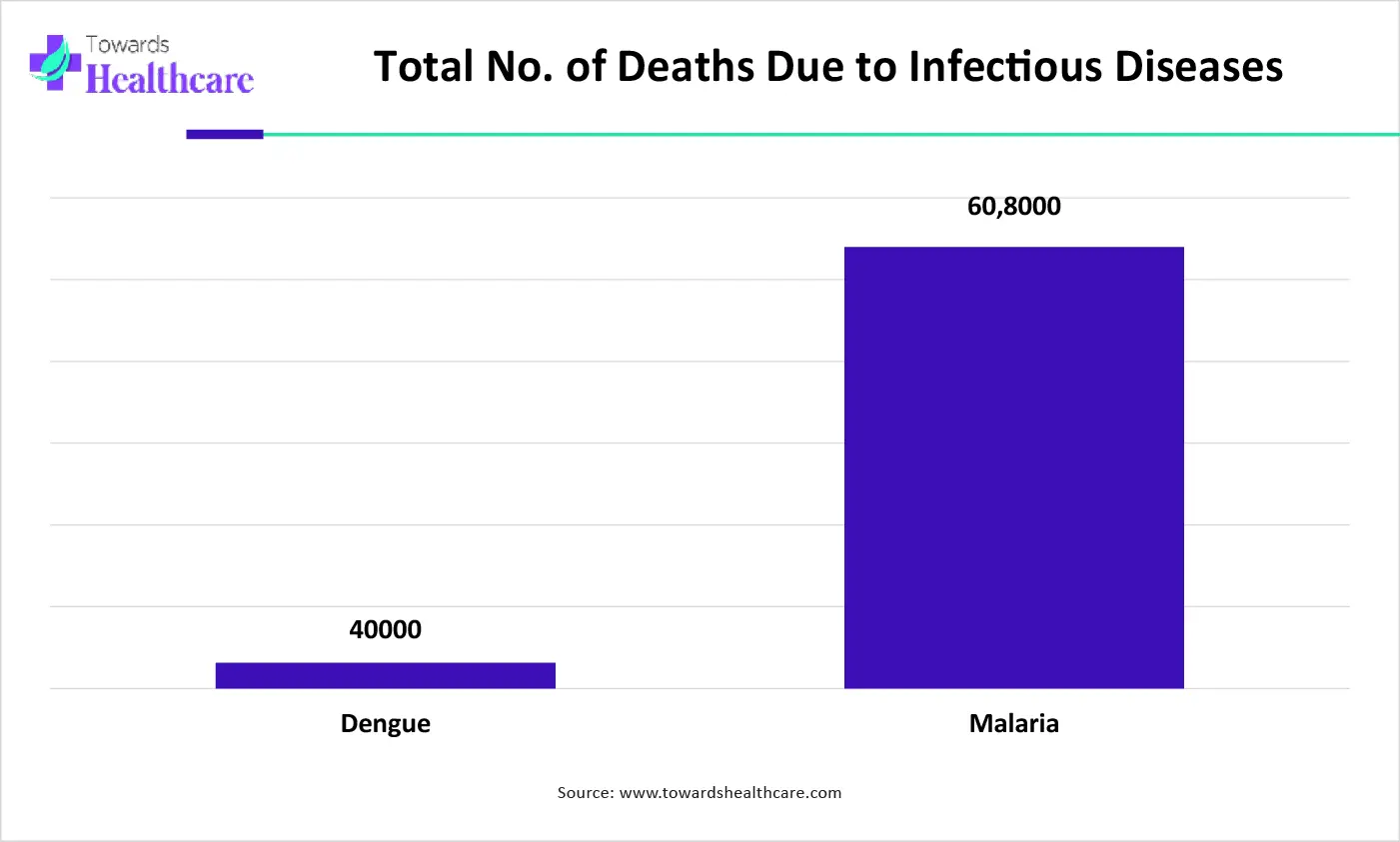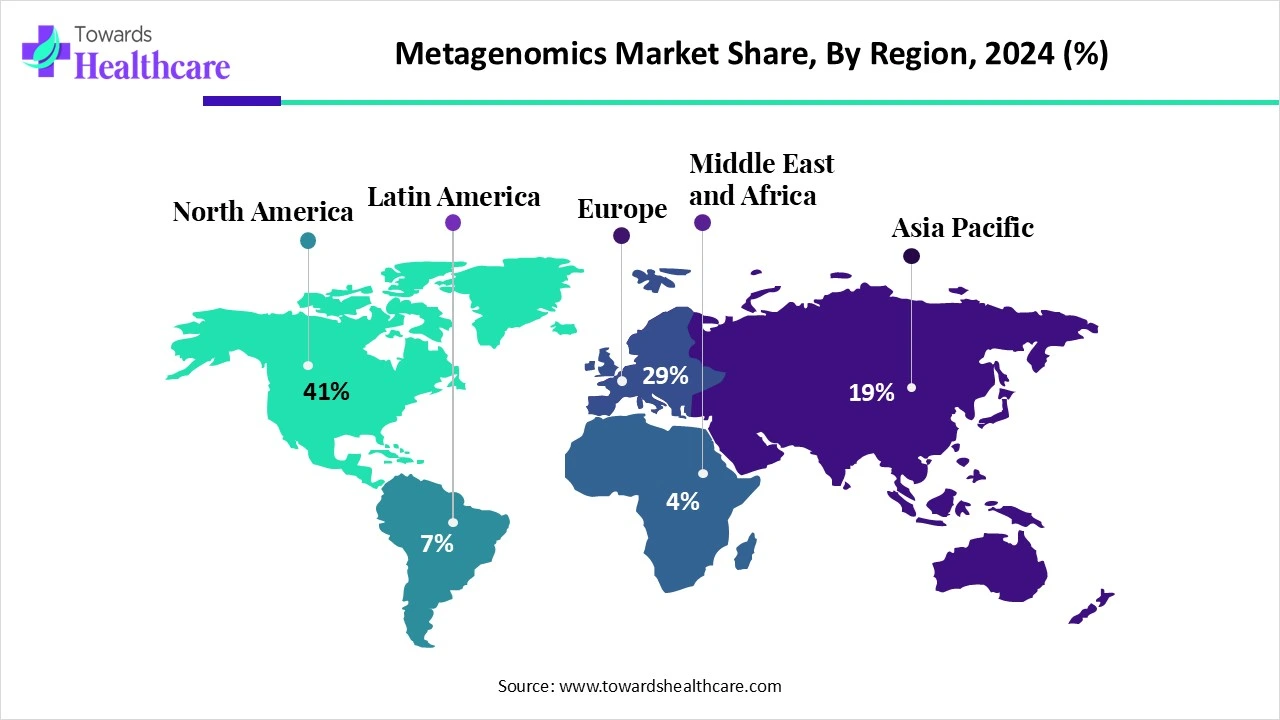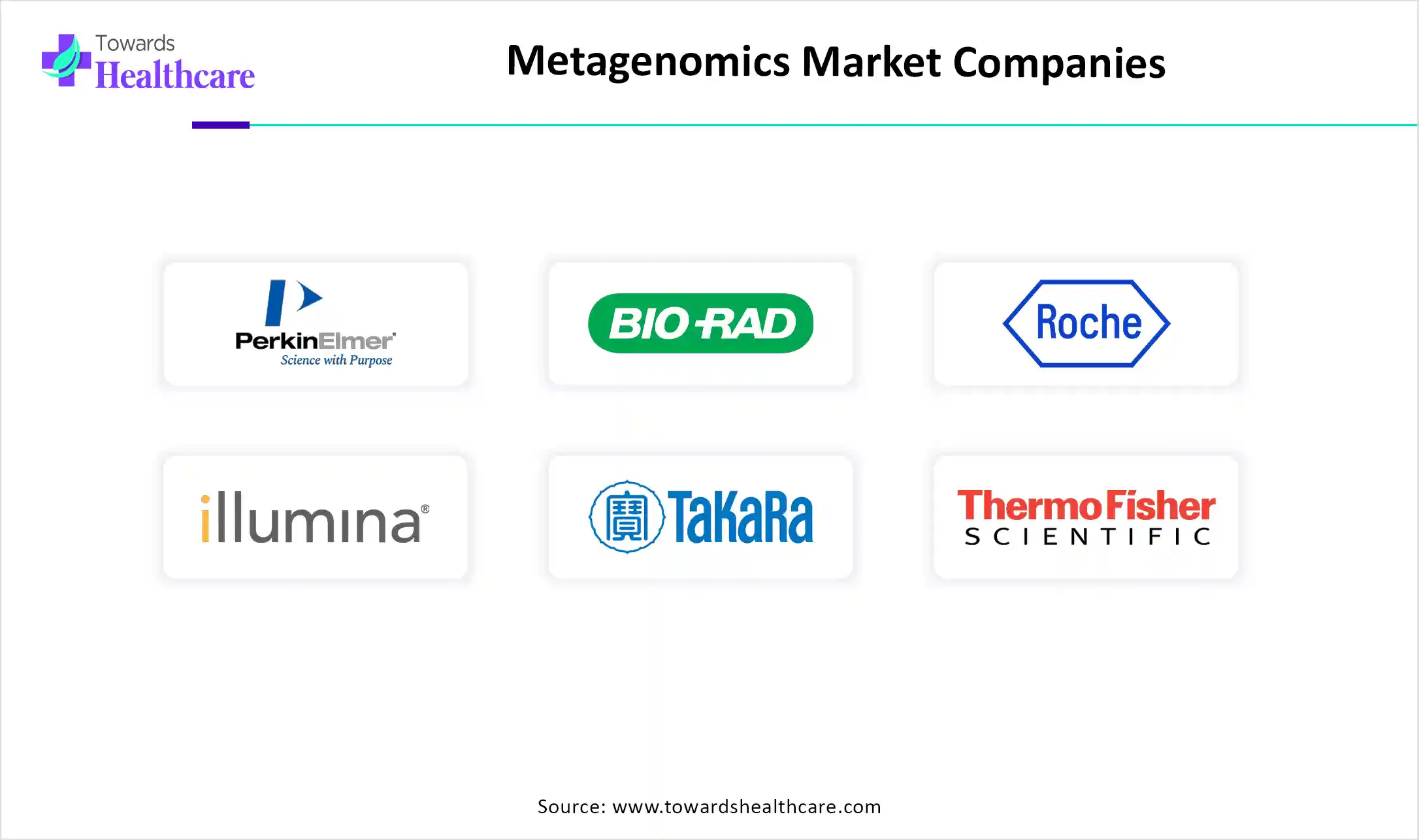November 2025

The global metagenomics market size is calculated at US$ 2.36 in 2024, grew to US$ 2.68 billion in 2025, and is projected to reach around US$ 8.39 billion by 2034. The market is expanding at a CAGR of 13.55% between 2025 and 2034.

The use of metagenomics in the detection of infectious diseases, antimicrobial resistance, as well as in microbiome research is increasing. Additionally, various developments to improve its next-generation sequencing techniques are also being made, along with the integration of AI. This, in turn, is increasing the collaborations among the companies. Similarly, its use in different regions is also increasing due to growing advancements, which are also supported by the government, as well as the private sector. Thus, this is promoting the metagenomics market growth.
| Metric | Details |
| Market Size in 2025 | USD 2.68 Billion |
| Projected Market Size in 2034 | USD 8.39 Billion |
| CAGR (2025 - 2034) | 13.55% |
| Leading Region | North America Share by 41% |
| Market Segmentation | By Product, By Technology, By Workflow, By Application, By Region |
| Top Key Players | PerkinElmer, Inc., Bio-Rad Laboratories, Inc, F. Hoffmann-La Roche Ltd., Illumina, Inc., Takara Bio, Inc., Thermo Fisher Scientific, Inc., Oxford Nanopore Technologies, Promega Corporation, Novogene Co., Ltd., QIAGEN |
With the use of metagenomics, the microbial DNA can be isolated, observed, as well as studied. At the same time, the microbial diversity and functional variability can also be assessed by metagenomics in the existing microbial community. Moreover, for microbial studies, it utilizes futuristic, cutting-edge, high-throughput, and state-of-the-art sequencing analysis, due to which it is an interdisciplinary field of genetics. Additionally, its use in infectious disease diagnosis, biotechnology, environmental conservation, environmental remediation, agriculture, and ecology is increasing due to its potential to penetrate and solve problems in different fields.
The AI integration with metagenomics can enhance the healthcare data evaluation in specifically related to pathogenicity or microorganisms. At the same time, it can be used in understanding the hidden functional microbial diversity within the human body as well as in the surroundings. Moreover, it also provides an interpretation of the data gathered, a prediction of outbreaks, as well as can be used in image analysis. Additionally, the workflow of disease diagnosis to vaccination can be simplified with the use of AI.
Rising Incidence of Infectious Diseases
There is a rise in the incidence of various infectious diseases. Thus, the demand for metagenomics increases. With the help of metagenomics, the causative agent can be detected easily. At the same time, it can also detect rare or complex microbial infectious diseases. Additionally, with the help of metagenomics, the resistant bacterial strains can also be detected without the need to culture the bacteria. Hence, the use of metagenomics in the fast and accurate detection of infectious diseases is increasing. Thus, this promotes the metagenomics market growth.

The graph represents the total number of deaths associated with infectious diseases every year. It indicates that there will be a rise in cases of infectious diseases. Hence, it increases the demand for the use of metagenomics to enhance the diagnostics and treatment options for its effective management. Thus, this in turn will ultimately promote the market growth.
Complex Data Interpretation
The data generated by the metagenomic sequencing consists of a large volume of DNA or RNA data. Hence, the interpretation of this data requires expertise or the use of software. Moreover, improper interpretation of this data can lead to wrong or inappropriate results. Thus, the complex data interpretation may limit the use of metagenomics.
Growing Advancements in Metagenomics
The increasing use of metagenomics in various sectors is enhancing its advancements. At the same time, their use in the development of probiotics, personalized medications, or skincare is also increasing, due to their ability to analyze the microbiome. Hence, various next-generation sequencing platforms with quick and accurate results at affordable prices are being developed, as well as their software applications are also being enhanced. Similarly, to predict antimicrobial resistance, various software or cloud platforms integrated with metagenomics are also being developed. Thus, this is promoting the metagenomics market growth.
For instance,
By product type, the kits & reagents segment held the largest share in the market in 2024. The kits & reagents were essential components used in metagenomics. These kits & reagents were also used in various fields, providing different applications. Thus, their consumption increased. This contributed to the market growth.
By product type, the sequencing & data analytics services segment is expected to show a significant growth rate at a notable CAGR during the upcoming years. The use of sequencing & data analytics for pathogen as well as microbiome detection is increasing. At the same time, the use of advanced technologies is increasing its applications and making it affordable.
By technology type, the shotgun sequencing segment led the market in 2024. The shotgun sequencing provided accurate results, which increased its use. Its use in the detection of antibiotic resistance, genetic diseases, or viral infections has also increased. Moreover, it was also used in clinical diagnosis, as microbiome detection. Thus, this enhanced the market growth.
By technology type, the 16S sequencing segment is expected to be the significant growing during the upcoming years. The use of 16S sequencing for large-scale samples is increasing. Furthermore, the results provided are quick and accurate. At the same time, the data generated is easier to interpret. Thus, all these factors and affordability are increasing its use.
By workflow type, the sequencing segment held the dominating share in the market in 2024. Sequencing is the most commonly used step in metagenomics. It helped in detecting the presence of bacteria, fungi, viruses, etc, in the biological samples. Moreover, it was also used to test the food safety. Thus, its use in hospitals, labs, or institutions increased, accelerating the market growth.
By workflow type, the data analysis segment is expected to show a significant growth rate during the predicted time. The use of data analysis is increasing as the data generated by metagenomics is large. Moreover, its growing use in clinical diagnosis is increasing the demand for data analysis. Additionally, to improve its accuracy, various developments are also being made.
By application type, the environmental segment led the global metagenomics market in 2024. The detection of microbial ecosystems in environmental samples has increased the use of metagenomics in environmental applications. At the same time, it was also used in the detection of soil fertility, pollution impact, crop productivity, etc. Thus, this promoted the market growth.
By application type, the clinical diagnostics segment is expected to be the significant growing during the predicted time. The growing diseases, as well as antimicrobial infections, are increasing the use of metagenomics in clinical diagnostics. Moreover, its use in the development of microbiome-based therapies and personalized therapies is also increasing.

North America dominated the metagenomics market share by 41% in 2024. The presence of well-developed industries in North America has increased the use of metagenomics for various applications. At the same time, they also contributed to its enhanced development, as well as improved its applications. This contributed to the market growth.
The industries in the U.S. are focusing on enhancing the analytical applications of metagenomics. At the same time, they are also developing next-generation sequencing platforms. This, in turn, is supported by technological integrations. Moreover, these advancements are also supported by the regulatory bodies.
Canada consists of an advanced healthcare sector, which in turn, contributes to the growing research and development in the field of metagenomics. This research is supported by the government investments. At the same time, the growing demand for precision or personalized medicines is also increasing the use of metagenomics.
Asia Pacific is expected to host the fastest-growing metagenomics market during the forecast period. The use of metagenomics in the Asia Pacific is increasing due to the growing prevalence of infectious diseases. Moreover, the growing antibiotic resistance is also increasing the adoption of metagenomics. Thus, this enhances the market growth.
China consists of a large population, which increases the risk of disease incidence, enhancing the use of metagenomics. At the same time, its use in microbiome detection is increasing to provide diet plans or in the development of personalized treatment approaches. Furthermore, the use of technological advancements is also improving its workflow.
The advancing healthcare in India is contributing to the increased use and adoption of metagenomics in the field of biotechnology as well as genomics. Moreover, the increasing diseases is increasing their use in early detection as well as in the development of treatment approaches. Furthermore, to encourage its use as well as to promote innovations, the government is also providing its support.
Europe is expected to grow significantly in the metagenomics market during the forecast period. The industries as well as institutes in Europe are eagerly contributing to enhancing the application of metagenomics. This, in turn, is also supported by the investment or funding provided by the government or private sector. Thus, this promotes the market growth.
The growing interest in the human microbiome in Germany is increasing the use of metagenomics. At the same time, these developments are increasing the use of metagenomics for the development of personalized nutrition approaches as well as in drug discovery. Furthermore, its use in the detection of antimicrobial resistance is also increasing.
The industries as well as institutions in the UK are focusing on enhancing the applications of metagenomics. This, in turn, is leading to new collaborations. Additionally, its use in the detection of rare or complex diseases as well as in precision medicine development is also growing. Furthermore, these developments are supported by the European Union and the government.
The Middle East & Africa are considered to be a significantly growing area, due to the rising prevalence of genetic disorders and growing research and development activities. People are becoming aware of personalized medicines, encouraging their development. Government organizations launch initiatives to support the development of precision medicines. Researchers are becoming aware of metagenomic technologies, with the availability of innovative metagenomic platforms.
The UAE government’s National Genomics Strategy aims to establish an integrated framework for genomic programs and turn the country into a hub for research and innovation in the field. In April 2025, the Department of Health – Abu Dhabi, Abu Dhabi Investment Office, and GSK signed an MoU to accelerate oncology-focused genomic science and precision medicine.
Latin America is expected to grow at a notable CAGR in the foreseeable future. The rapidly expanding biotech sector and favorable government support drive the market. Government bodies and regulatory authorities make constant efforts to strengthen the regulatory framework for supporting metagenomics. The rising adoption of advanced technologies enables researchers to develop innovative diagnostics and therapeutics.
Brazil recently launched a nationwide initiative to generate high-quality and high-quantity genomic data to support conservation and bioeconomy policies. The genomic technology in Brazil is emerging, with government initiatives and investments. The Brazilian Initiative on Precision Medicine aims to facilitate the implementation of precision medicine in Brazil.

By Product
By Technology
By Workflow
By Application
By Region
November 2025
November 2025
November 2025
November 2025